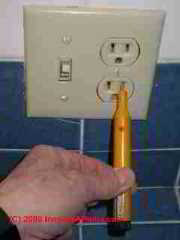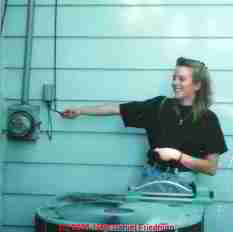 Electrical Test Tools Choices & Tool Procedures for Electrical Inspectors & Home Inspectors
Electrical Test Tools Choices & Tool Procedures for Electrical Inspectors & Home Inspectors
- POST a QUESTION or COMMENT about using multimeters, digital multimeters, and volt-ohm meterrs safely during building electrical systems inspection, testing, diagnosis, or repair
Guide to electrical test tools for electricians, service technicians, building inspectors: this article discusses several inexpensive and useful test tools for the electrical inspector, home inspector, or other professionals who examine residential electrical systems.
InspectAPedia tolerates no conflicts of interest. We have no relationship with advertisers, products, or services discussed at this website.
Guide to Using Electrical System Test Equipment to Check Electrical Equipment, Components or Electrical System Safety
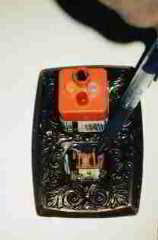 Fatal Shock Hazard Warning: Inspecting electrical components and systems risks death by electrocution as well as serious burns or other injuries to the inspector or to others. Do not attempt these tasks unless you are properly trained and equipped.
Fatal Shock Hazard Warning: Inspecting electrical components and systems risks death by electrocution as well as serious burns or other injuries to the inspector or to others. Do not attempt these tasks unless you are properly trained and equipped.
Proceedings of the ASHI Home Inspector Educational Seminar: ASHI-NE Chapter Annual conference,
September 22-23, 2008, Randolph, MA. -- Daniel Friedman.
Original text - Daniel Friedman, as ASHI Technical Journal Staff, January 1992,updates February 2006, September 2008.
This is the full text version. A powerpoint presentation version of this class is also available.Article Contents
- TEST EQUIPMENT, ELECTRICAL GUIDE
- FIRST USE YOUR HEAD
- USING a TIC TRACER™ to TEST for CURRENT
- USING other NON-CONTACT VOLTAGE SENSING TOOLS
- USING a NEON TESTER to TEST for LIVE VOLTAGE & GROUND PATHS
- USING an ELECTRICAL RECEPTACLE TESTER to CHECK VOLTAGE & WIRING
- USING a DMM or VOM to CHECK for CURRENT
- SAFE USE of ELECTRICAL TEST EQUIPMENT
These electrical inspection suggestions are not a complete inventory of all electrical components that should be inspected; nor have we described all of the electrical test tools popular among home inspectors and electrical inspectors.
For example the SureTest® Circuit Analyzer model 61-164 and 61-165 made by the Ideal Corporation is quite popular among many home inspectors. (We'd welcome a contribution on the proper use of this tool.) Sometimes circuit analyzers are misused in testing aluminum wiring, FPE Stab-Lok equipment and AFCIs. Contact Us by email to suggest changes, corrections, and additions to this material.
First use your head: stop, look listen, before touching anything, use safety equipment
Stop, look, listen before touching. More on "just looking" is provided when we discuss opening the electrical panel. Do not rely on touch to determine if electrical equipment is safe.
Details about the hazards of touching electrical equipment and alternative advice for determining whether or not equipment is safe to inspect are provided at Touching Electrical Equipment.
Guide to Using a Tic Tracer™ to Test for Presence of Electrical Voltage
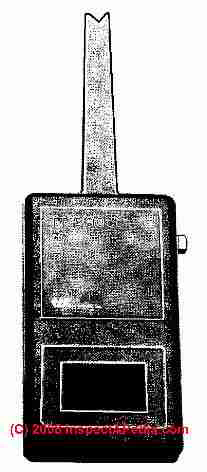 This is a superb safety tool for testing for the presence of live 120VAC or 240VAC because you do not actually need to touch the tool to anything - just hold the tool near a source of electrical power and the electrical field produced will cause the tool to generate its tone.
This is a superb safety tool for testing for the presence of live 120VAC or 240VAC because you do not actually need to touch the tool to anything - just hold the tool near a source of electrical power and the electrical field produced will cause the tool to generate its tone.
Faster "ticking" indicates higher voltage; slow ticking can indicate a wire connected to a live circuit even if the wire is not presently conducting current.
With practice the inspector can guess the voltage level from the tone quality.
We use this tool to check light sockets for power when there is no bulb or the bulb is dark. We also use this tool to look for lost or hidden wiring in walls and ceilings.
Its sensitivity falls off with the square of the distance from the source of electrical power.
Weird and interesting behavior of the TIF Tic Tracer:
Some ASHI NE chapter inspectors pointed out that this device can be "fooled" into thinking that a wire scrap is "live" or that even a pipe is electrically "live" when it is not.
If a live electrical wire passes close enough to another metal device such as a pipe, electrical conduit, or armored cable, the metal device, conduit, or cable may pick up the electrical field generated by the "live wire" and appear "live" itself when it is not.
(This is a "safe" error in that it errs in the direction of warning that something is live when it is not.)
This tool will also respond to momentary static electricity. In winter, simply rubbing its tip quickly across a wall can produce a momentary sound response. (Which can be fun in certain circumstances.)
The Tic Tracer™ is discussed further along with examples of how this tool is used at TOUCHING EQUIPMENT.
Inspectors who object to the "false positive" possibility make use of a light-pen or similar tool which performs similar functions with less sensitivity to false positives.
Guide to Using Non-Contact Voltage Sensing or Voltage Detection Tools
Alternative AC and DC non-contact voltage sensing tools including pen-sized current sensors and even the simple neon-tester, below are available to perform this function.
The Tif™ Tic Tracer™ and other inexpensive pen-type voltage sensors (GB® non-contact voltage sensor, Greenlee Voltage Detector, Sperry® non-contact voltage sensor, Global Cache™, PasPort® and FCB Voltage Pen (Photo at left)), offer the advantage that it is not necessary to actually touch equipment, a surface, or a wire, to sense the presence of live voltage. Some voltage sensing models incude an adjustment to the sensitivity of the device.
SAFETY TIP: Greenlee and other manufacturers recommend that you test the operation of the voltage detector on a known live circuit both before and after using it to test for the presence of electrical voltage at a wire or device.
VOLTS / AMPS MEASUREMENT EQUIP describes other electrical test equipment including the Greenlee GT-16 adjustable voltage detector.
Guide to Using a Neon Tester to Test for Live Voltage or for Ground Paths
A simple neon tester is perhaps a simple, versatile tool for checking for the presence or absence of voltage. It requires touching electrical contacts or grounded surfaces to function.
Just touch one leg of the tester to the surface to be checked (a wire terminal or an electrical panel enclosure). Touch the second leg of the neon tester to a sure-ground such as a water pipe that you see continues into soil. If voltage is present within the range of sensitivity of the neon tester's bulb, the bulb will light.
We discuss neon testers for voltage at ELECTRICAL TOOLS BASIC
A detailed example of safe use of a neon tester to check for voltage is at REPAIR AUTOMATIC OUTDOOR LIGHT FIXTURE.
Tips for Using an Electrical Receptacle Tester to Check for Voltage & Proper Wiring Connections
Receptacle testers are used by most home inspectors to check for proper wiring at electrical receptacles as well as to check the function of GFCI's.
For testing AFCI's the only reliable test currently available is the device's own test button.
We provide details about using receptacle testers at Electrical Tools Every Homeowner Should Have
Neither of these neat little electrical test tools can be relied on to report low levels of current leakage.
At an investigation of a garage roof that shocked a crew of builders during reconstruction after a lightning strike, we measured voltage varying between about 38 volts AC and 68 volts AC between some framing components and the earth. We could not detect these conditions with a neon tester. A VOM or DMM was needed.
Introduction to Using a DMM or VOM to Check for Current
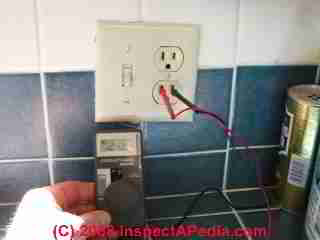 A simple volt ohm meter volt-ohmeter (VOM) such as the TriplettTM 310
or our little mini digital multimeter (DMM) shown at left can be used to test for unexpected and unsafe voltage at a component.
A simple volt ohm meter volt-ohmeter (VOM) such as the TriplettTM 310
or our little mini digital multimeter (DMM) shown at left can be used to test for unexpected and unsafe voltage at a component.
- Set the VOM in the highest AC-voltage range.
- One probe is used to contact the surface of the electric panel (or any component to be examined)
- The other probe is touched to a reliable ground source, or in the example shown, to the neutral side of the circuit.
NOTE: Once having tested at the highest voltage range, greater accuracy may be obtained by choosing more sensitive ranges which permit readings to be taken in the upper portion of the scale. Disconnect the test probes (or shut off the voltage source) before changing the voltage range setting on the VOM.
Details on safe use of DMM's and VOMs are at DMMs VOMs SAFE USE OF.
For example, if the meter indicates more than 1or 2 volts between a service panel cover and ground, there's a safety problem. Most low-cost analog-type meters such as the one described provide additional ranges used to read lower voltages with more sensitivity.
Some VOM models provide alligator clips for the ends of the test probes. These clips permit measuring high voltage without handling the probes. Always shut off the power before connecting the alligator clips.
Safe Use of Electrical Test Equipment: DMMs & VOMs
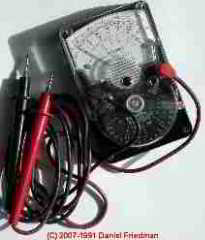 8.3 During an electrical system inspection the inspector is NOT required to
8.3 During an electrical system inspection the inspector is NOT required to
8.3.A. insert any tool, probe, or testing device inside the panels
In some circumstances ASHI inspectors may elect to make current and voltage measurements. For inspectors who elect to use these tools, make sure that the tools themselves do not become a source of damage, or injury.
Use only DMM's (digital multi meters) or VOMs (volt-ohm meters, the analog predecessors to DMMs) designed for high energy measurements.
Details about safe use of VOMs and DMMs are provided
at DMMs VOMs SAFE USE OF
ELECTRICAL INSPECTOR SAFETY PROCEDURES describes important basic safety procedures, clothing, and equipment for home inspectors and electrical inspectors.
Details about the hazards of touching electrical equipment and alternative advice for determining whether or not equipment is safe to inspect are provided
at TOUCHING ELECTRICAL EQUIPMENT
...
Continue reading at ELECTRICAL TOOLS BASIC or select a topic from the closely-related articles below, or see the complete ARTICLE INDEX.
Or see these
Recommended Articles
Suggested citation for this web page
TEST EQUIPMENT, ELECTRICAL at InspectApedia.com - online encyclopedia of building & environmental inspection, testing, diagnosis, repair, & problem prevention advice.
Or see this
INDEX to RELATED ARTICLES: ARTICLE INDEX to ELECTRICAL INSPECTION & TESTING
Or use the SEARCH BOX found below to Ask a Question or Search InspectApedia
Ask a Question or Search InspectApedia
Questions & answers or comments about using multimeters, digital multimeters, and volt-ohm meterrs safely during building electrical systems inspection, testing, diagnosis, or repair.
Try the search box just below, or if you prefer, post a question or comment in the Comments box below and we will respond promptly.
Search the InspectApedia website
Note: appearance of your Comment below may be delayed: if your comment contains an image, photograph, web link, or text that looks to the software as if it might be a web link, your posting will appear after it has been approved by a moderator. Apologies for the delay.
Only one image can be added per comment but you can post as many comments, and therefore images, as you like.
You will not receive a notification when a response to your question has been posted.
Please bookmark this page to make it easy for you to check back for our response.
Our Comment Box is provided by Countable Web Productions countable.ca
Citations & References
In addition to any citations in the article above, a full list is available on request.
- Electrical shock injury statistics: www.healthatoz.com - September 2008;
- Daniel Friedman - Publisher & Editor of InspectAPedia.com®
- [2] N. Srinivasan, MSEE, is a senior member of IEEE with 30 years experience in the electrical industry. Mr. Srinivasan is in Vienna VA.
- [3] Louis P. Babin generously contributed technical editing about the effects of doubling ampacity in an electrical circuit (September 2007)
- [4] Digisnap DSA-500 snap-around digital multimeter, A.W. Sperry Instruments Inc., 2150 Joshua's Path, Suite 202, Hauppage NY 11788, Tel: 800-645-5398, Email: cat@awsperry.com, Website: www.awsperry.com
- [5] Fluke Corporation, 6920 Seaway Blvd, Everett, WA 98203, USA, PO Box 9090 Everett, Washington 98206, Tel: +1(425) 347-6100, Technical support: 1(800) 44-FLUKE (1(800) 443-5853), Website: www.fluke.com,
Fluke Europe B.V, PO Box 1186 Eindhoven, The Netherlands, Tel: +31 (0)40 2 675 200 +31 (0)40 2 675 222, Website: www.fluke.eu- Fluke India: TTL India Pvt. Ltd. (A Fluke Company), Deodhar Center, 424, Marol Maroshi Road, Andheri (E), Mumbai, 400076, Tel: 1 800 209 9110, Email: info.india@fluke.com, Website: http://www.fluke.com/fluke/inen/products/Digital-Multimeters.htm
- Digital 287/289 Digital Multimeter, Users Manual, retrieved 9/5/21, original source: http://assets.fluke.com/manuals/287_289_umeng0200.pdf, [copy on file as Fluke_287_289_umeng0200.pdf]
- [6] Simpson Electric, P.O. Box 99, 520 Simpson Avenue, Lac du Flambeau, WI 54538-0099 Tel: 715-588-3311, customer service: 715-588-3947, Email: support@simpsonelectric.com, Website: www.simpsonelectric.com/
- Simpson 260® Series 6XLM Volt-Ohm-Milliammeter Instruction Manual, retrieved 9/5/2012, original source: http://www.simpsonelectric.com/uploads/File/datasheets/260-6xlm.pdf, [copy on file as Simpson_260-6xlm.pdf]
- [7] tif 300cc Tic Tracer voltage detector, Tif Instruments Inc., 9101 NW 7th Avenue, Miami, Florida 33150
- [8] Greenlee® GT-16 adjustable voltage detector, Greenlee Textron Inc., Website: greenlee.com, Tel: 800-435-0786 , Email: echsupport@greenlee.textron.com,
- [9] Jensen VOMs, no longer available
- [10] Mastech VOMs and DMMs (made in China), Shanghai Hihua V&A Instrument Company, 881 Ye Cheng Road Jia Ding District, Shanghai 201821, China, Email: mastech@vip.sina.com, Tel: +86 21 69523164 +86 21 69523225, Website: http://www.mastech.com.cn/
- [11] Equus Multimeters by Innova, Equus Products, Inc., 17352 Von Karman Ave., Irvine, CA 92614, U.S.A., Tel: 714-241-6800, Website: http://www.equus.com/
- [12] Actron DMMs & VOMs, Website: http://www.actron.com/
- [13] ExTech DMMs & VOMs, ExTech Corp. a FLIR company, Extech Instruments Corporation, 9 Townsend West, Nashua, NH 03063, U.S.A., Email: support@extech.com, Tel: 877-239-8324 Option 3, Website: http://www.extech.com
- [15] Dr. Jess Aronstein, consulting engineer, Poughkeepsie NY, 1991 protune@aol.com
- [16] Rex Cauldwell, master electrician and contributor to the Journal of Light ConstructionOn electrical topics
- [17] New York State Central Hudson Gas and Electric Company, G&E/1-2/85 consumer safety pamphlet
- [21] ASHI Technical Journal, Vol. 2. No. 1, January 1992, "Determining Service Ampacity," Dan Friedman and Alan Carson, and the
- [22] ASHI Technical Journal, Vol. 3. No. 1, Spring, 1993, "Determining Service Ampacity - Another Consideration," Robert L. Klewitz, P.E., with subsequent updates and additions to the original text ongoing to 2/19/2006. Reprints of the originals and reprints of the Journal are available from ASHI, the American Society of Home Inspectors www.ashi.com.
- [23] Rust and Corrosion in Electrical Panels, A Study and Report on Frequency and Cause for Electrical and Home Inspectors at Residential Electric Panels
- [24] "Electrical System Inspection Basics," Richard C. Wolcott, ASHI 8th Annual Education Conference, Boston 1985.
- [25] "Simplified Electrical Wiring," Sears, Roebuck and Co., 15705 (F5428) Rev. 4-77 1977 [Lots of sketches of older-type service panels.]
- [26] "How to plan and install electric wiring for homes, farms, garages, shops," Montgomery Ward Co., 83-850.
- Our recommended books about building & mechanical systems design, inspection, problem diagnosis, and repair, and about indoor environment and IAQ testing, diagnosis, and cleanup are at the InspectAPedia Bookstore. Also see our Book Reviews - InspectAPedia.
-
Electrical Books section of the InspectAPedia Bookstore. (courtesy of Amazon.com)
- In addition to citations & references found in this article, see the research citations given at the end of the related articles found at our suggested
CONTINUE READING or RECOMMENDED ARTICLES.
- Carson, Dunlop & Associates Ltd., 120 Carlton Street Suite 407, Toronto ON M5A 4K2. Tel: (416) 964-9415 1-800-268-7070 Email: info@carsondunlop.com. Alan Carson is a past president of ASHI, the American Society of Home Inspectors.
Thanks to Alan Carson and Bob Dunlop, for permission for InspectAPedia to use text excerpts from The HOME REFERENCE BOOK - the Encyclopedia of Homes and to use illustrations from The ILLUSTRATED HOME .
Carson Dunlop Associates provides extensive home inspection education and report writing material. In gratitude we provide links to tsome Carson Dunlop Associates products and services.


